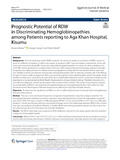| dc.contributor.author | Mutua, Benard | |
| dc.contributor.author | Sowayi, George | |
| dc.contributor.author | Okoth, Patrick | |
| dc.date.accessioned | 2022-09-19T12:02:25Z | |
| dc.date.available | 2022-09-19T12:02:25Z | |
| dc.date.issued | 2022-08-13 | |
| dc.identifier.uri | https://doi.org/10.1186/s43042-022-00334-5 | |
| dc.identifier.uri | https://jmhg.springeropen.com/articles/10.1186/s43042-022-00334-5 | |
| dc.identifier.uri | http://ir-library.mmust.ac.ke:8080/xmlui/handle/123456789/2098 | |
| dc.description.abstract | Background
Red cell distribution width (RDW) measures the extent of variation in red blood cell (RBC) volume in terms of coefficient of variation. It reflects the degree of variation in RBC’s sizes and shapes, characteristic of iron deficiency and anemias involving RBC destruction, especially hemoglobinopathies. Its values are often available as one of the RBC indices generated as complete blood cell count (CBC) using automated hematology analyzers. Hemoglobinopathies are highly prevalent in malaria-endemic geographical settings like the Sub-Saharan African which has over 200,000 currently documented annual major hemoglobinopathies with an alarming mortality rate of 50–90% by the age of 5 years usually undiagnosed. With a vast growing majority of hemoglobinopathy carriers, this public health problem is projected to escalate by the year 2050 due to unaffordable laboratory tests for screening of newborns and populations as recommended by World Health Organization in resource-limited settings. Therefore, innovative of a cost-effective diagnostic method would improve the survival of these children. The current study aimed to evaluate the overall ability of RDW in discriminating hemoglobinopathy and hemoglobinopathy-free cases within the Lake Victoria Economic Block region of Western Kenya served partly by the Aga Khan Hospital, Kisumu.
Objective
To determine the significance of RDW as a tool to differentiate between individuals with hemoglobinopathies and those without.
Method
This was a cross-sectional retrospective comparative hospital-based study that analyzed data from the hematology laboratory database for patients examined using high-performance liquid chromatography during the years 2015–2020. The study consisted of 488 participants (49.4%, n = 241 control; 50.6% n = 247 case, p = 0.786) aged between 1 month and 66 years selected conveniently through census. The relationship between RDW of the controls and cases was analyzed using Mann–Whitney U, Kruskal–Wallis tests among population groups and Dunn’s post hoc test within groups since the data were non-normally distributed.
Results
The RDW cutoff value was computed at 95% confidence interval (CI), and values greater than this indicated a diagnosis of hemoglobinopathy.
Conclusion
RDW at 95% CI was 19.9 [14.5 + (2.7 × 2 = 19.9)] cutoff point which proved to be an excellent screening tool for sickle cell disease phenotypes in Western Kenya but would generate many false positive and false negatives for pure Hb AS. RDW is a poor screening tool for, Hb AS + HbF, Hb AS + β thal and β-thalassemia since it could not differentiate diseased from non-diseases populations. Even though RDW proved to be a poor screening tool for beta thalassemia, other complete blood count (CBC) parameters such as MCV and red cell count can be used to identify thalassemia syndromes as well as iron deficiency anemia. Though out of the scope of this work, highlighting the significance of these parameters in addition to the RDW would improve its feasibility as a screening tool for all hemoglobinopathies. Normal reference range for children ≤ 5 years needs to be developed using prospective data for precise marking of disorders associated with red cell anisocytosis, and individuals ≥ 6 years can share RDW normal reference range regardless of their gender. | en_US |
| dc.language.iso | en | en_US |
| dc.publisher | Egyptian Journal of Medical Human Genetics | en_US |
| dc.subject | Prognostic, Potential, RDW, Discriminating, Hemoglobinopathies, Patients, Hospital, | en_US |
| dc.title | Prognostic Potential of RDW in Discriminating Hemoglobinopathies among Patients reporting to Aga Khan Hospital, Kisumu | en_US |
| dc.type | Article | en_US |

